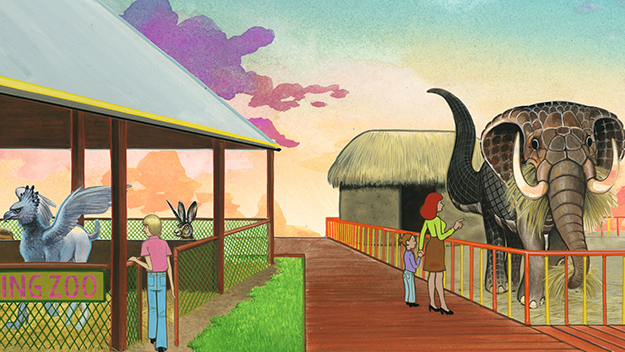Film Comment Recommends: Cryptozoo
This article appeared in the August 19 edition of The Film Comment Letter, our free weekly newsletter featuring original film criticism and writing. Sign up for the Letter here.

Cryptozoo (Dash Shaw, 2021)
“A small child is taken to the zoo for the first time,” write Jorge Luis Borges and Margarita Guerrero in the preface to The Book of Imaginary Beings. “This child may be any one of us or, to put it another way, we have been this child and have forgotten about it.” Cryptozoo, a sort of cinematic equivalent of Borges and Guerrero’s make-believe bestiary, similarly attempts to renew a jaded audience’s capacity for awe and terror. Its subject matter is not just cryptids, but the whole lineage of adult animation and trippy cult films, from Ralph Bakshi to The Last Unicorn.
Cryptozoo opens with naked hippies rendered in loose, black line drawings, and voiced by Michael Cera and Louisa Krause with aptly zonked and grating inflections. They spark a joint, then stumble into a garden of unearthly delights. But this is no return to Eden: Paradise is quickly lost when one of them is impaled by a unicorn. This is the Cryptozoo, where fantastic beasts like the Kraken and Pegasus can be found alongside the gift shop.
Alt-comic artist Dash Shaw began to conceive the film when his wife—co-director and animation director Jane Samborski—became the dungeon master of an all-female Dungeons & Dragons group. Samborski was responsible for many of the film’s hand-painted character templates, and together, she and Shaw achieve an eclectic illustration palette, with different styles of backgrounds for different set pieces, and references to Aubrey Beardsley tarot cards, Al Jaffee’s Mad magazine’s fold-ins, and the watercolors of Belladonna of Sadness.
The film’s omnibus look fits its foregrounded discourse about the ethics of ethnography, via a Fantastic Planet–esque zoological allegory. Cryptozoo founder Joan (voiced by Grace Zabriskie), an old caftan liberal in a mixed-species marriage, trades perspectives with ace cryptid hunter Lauren Gray (Lake Bell) and turbaned gorgon assistant Phoebe (Angeliki Papoulia) on exoticism, preservation, and cryptid emancipation, all while racing against the Belloq-like Nicholas (Thomas Jay Ryan) and his faun assistant Gustav (Peter Stormare) to find the rarest beast of all: baku, the Japanese dream-eater.
Shaw has spoken of the influence of ’60s underground newspapers, and John Carroll Kirby’s dreamy psych score is squarely of a piece with the film’s New Age lineage. But Shaw is working at a remove. We glimpse Epcot Center in the film, under construction, in an ominous prophecy of the Disneyfication of ’60s international-village utopianism—a fall from innocence paralleled, perhaps, in the way Cryptozoo itself devolves into a Jurassic World–style disaster blockbuster. (Another mythic beast that comes to mind is the ouroboros.) This meta-cult film reflects on the soured dreams of many countercultures, not least that of underground cinema itself.
Mark Asch is a contributor to Nylon, Little White Lies, and elsewhere. He lives in Brooklyn.







